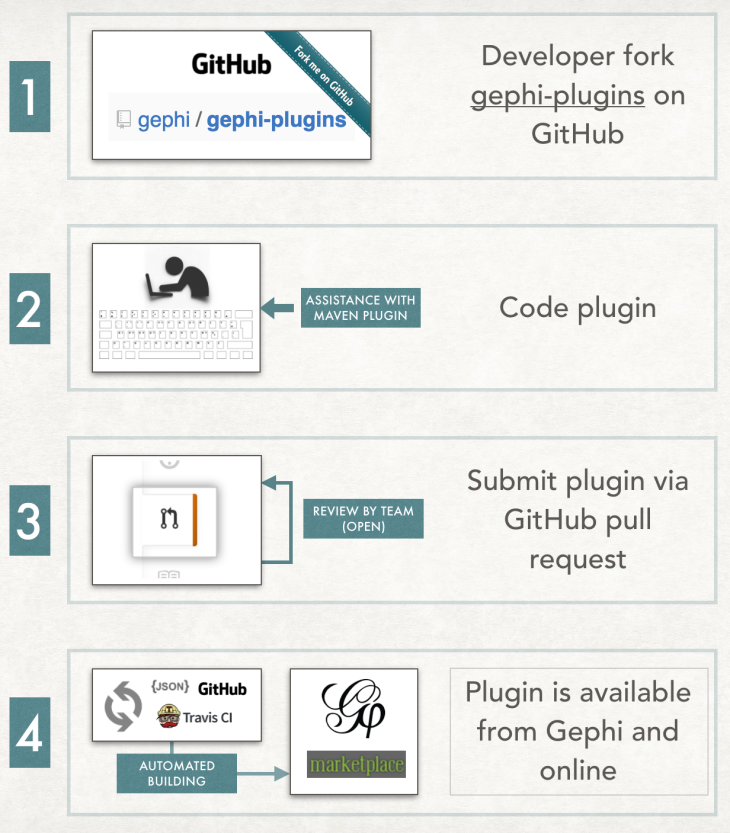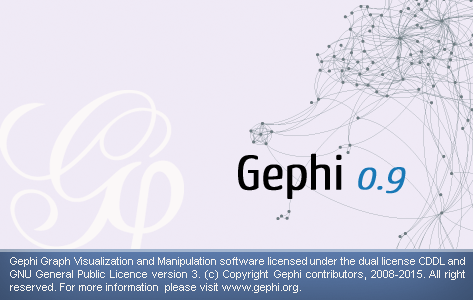Since the introduction of the Gephi Marketplace and tools such as the Plugins Bootcamp we’ve seen more and more plugins being developed. Even developers with little experience with Java give it a try and succeed in creating their first plugin. We want developers to be productive and make it as easy as possible to get started with plugin development and find help along the way. As the release of the 0.9 version is near, it’s time to review our plan on that matter and upcoming improvements. Here’s the summary:
- The gephi-plugins base repository (i.e. repository plugin developers fork) is now using Maven for building and is simpler. It contains only 4 files versus 890 for the Ant-based system.
- All Gephi modules are published on Maven central, making it very easy to inspect and extend.
- Introduction of a custom Maven plugin designed to facilitate plugin development.
- The submission and review of plugins will be entirely based of GitHub, making it more scalable and transparent.
- A new online portal for plugins is coming up with an easier edit experience and new features.
From Ant to Maven
Before diving into plugins, let’s first review what has changed on how Gephi is compiled, built and packaged – as this directly affects plugins as well. Since the Gephi 0.8.2 version we have migrated our build system from Ant to Maven. This is in line with what the Netbeans Platform (i.e. which Gephi is based on) community recommends. It already has increased the level of automation we’re capable of as a result. The main benefits are (compared to Ant):
- Maven is great at dependencies management. It’s now very clear what version of what library Gephi depends on, making it simpler to integrate. Dependencies are also downloaded automatically instead of being checked in the codebase
- Unlike the Ant-based system, it’s independent from Netbeans. This allows developers not using Netbeans to develop Gephi and produce a build entirely from the command-line.
- Gephi modules can now be placed on Maven Central (i.e. global repository where Maven finds its dependencies). This allows plugins to automatically find the Gephi dependencies online, reducing the manual steps at each Gephi upgrade.
Build assistant
There are a few critical steps we want to help plugin developers with and as a result started the development of a custom Maven plugin. This new tool will work behind the scenes when developers build their plugin. No installation or configuration is needed as it comes already as dependency of the gephi-plugins module. It already addresses common pain points and hope to automate more and more of the steps in the future. This is what it can do as of today:
- Plugin validation: The assistant reviews the plugin configuration and metadata at each build. This allows for instance to check if the plugin depends on the correct Gephi version or remind the developer to define an author or license in its configuration.
- Run Gephi with plugins: A single command allows to run Gephi with the plugins pre-installed. This makes testing faster than ever when developing plugins.
- New plugin generator: A step-by-step command-line tool that creates the correct folder structure and configuration to get started.
In the future, we want to rely on this build assistant to further automate the process and for instance do easy migration or code generation. For instance, you could ask to generate a Layout plugin code and configuration. Afterwards, all needed would be to fill in the blanks in the code.
A new way to review and submit plugins
As the number of plugins grows, it’s important to have a clear process how plugins are reviewed and updated. We also want this process to be transparent and open to the community. So far, the process was based on the submission of the plugin binaries with a manual review done by the team. This helped us get where we are today, but we want to get it to the next level and propose to entirely move this process to GitHub – using the pull-request mechanism. This has multiple advantages, listed below:
- Reviewing new/updated plugins can scale because any developer can read the code and contribute to the pull requests.
- Developers are already asked to fork the gephi-plugins repository so submitting the plugin via GitHub is a natural extension to it.
- There’s a clear history of each version, comment and what code has changed from one version to another.
- It makes it easier to test plugins and detect issues before the plugin is approved.
As part of this migration, we’ll no longer add plugins with closed source code but all existing plugins for Gephi 0.8.2 will remain available. For security and stability reasons, it’s essential that each plugin’s code can be inspected before approval. In order for this to work, all existing plugins not already on GitHub or not forking the gephi-plugins repository will need to migrate. For those already set up, the migration will be easier but Ant-based plugins will still need to migrate to Maven.
To summarize, this is what the new 4-steps process looks like for developers:

In the current submission process we ask for additional information such as description, author or license as well as allow the upload of images. Going forward with GitHub, all of these data will directly be defined in the plugin’s configuration making it easier to update.
A new home for plugins (again)
Plugins are currently available online from the Gephi Marketplace, where users could also reach people providing teachings and support. We have ideas on how to improve these community services and will be migrating them to a new architecture, starting with the plugins. We will tell you more about these changes in an upcoming post but for now our focus is on developing a new lightweight plugin portal that can directly be connected with the data source on GitHub.
Here is a preview of what it will look like for plugin pages:

The content of this website will be automatically updated when plugins are published or updated. The way it works is with Travis CI (i.e. continuous integration platform) simply refreshing the JSON file after changes to the plugin repository on GitHub. Developers can even embed images and write the description in Markdown. This will remove entirely the need for plugin developers to login to the marketplace, update NBMs and metadata.
Migrating plugins
This new Maven-based repository along with the new submission process will be introduced with the Gephi 0.9 release. Let’s review what plugin developers need to know to bring their plugin to this new major version.
As with all major Gephi release, plugins compatibility needs to be evaluated as APIs may have changed. In fact, given this new version is based on an entirely redeveloped core it’s very likely code changes will be required. Hopefully, these changes will often be minor and actually simplify things (i.e less, more efficient code). Documentation will be published on these API changes and core developers will be available to answer questions as well.
Plugin developers will also get contacted regarding moving their code to GitHub with a step-by-step guide. We’re considering adding a migrate command to the new Gephi Maven plugin to facilitate the transition from Ant but that’s an unfunded project at the moment (if you’re interested contributing to that, please let us know). Stay tuned for details right after the release on the path to migration.
And again, thanks for all your hard work on bringing your ideas to life though new Gephi plugins!




 We are happy to announce we finished the migration of our code from
We are happy to announce we finished the migration of our code from